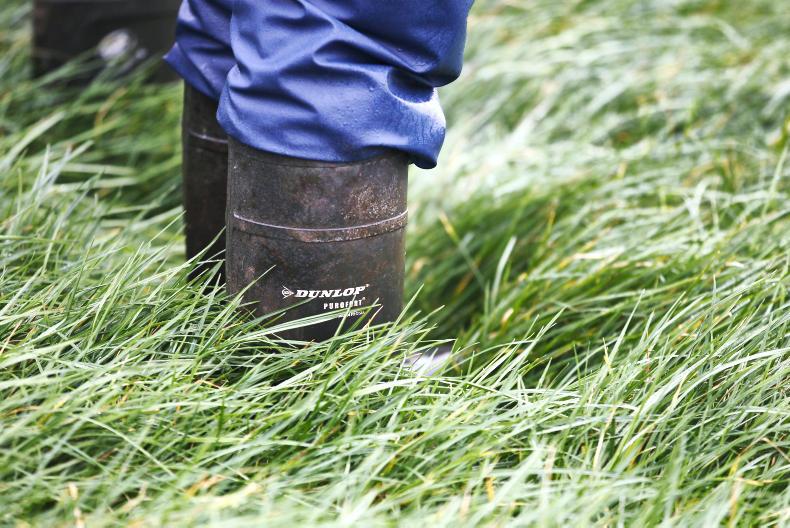Agricultural grasslands on the island of Ireland are potentially sequestering up to 11m tonnes of carbon dioxide from the atmosphere every year and offsetting over 40% of all the carbon emissions from agriculture north and south.
When compared against methane emissions from livestock in Ireland (14.5m tonnes of CO2 equivalent between north and south), these figures suggest up to 75% of all methane emissions are being offset by carbon sequestration.
Years of research and grassland experiments from Northern Ireland’s Agri-Food and Biosciences Institute (AFBI) shows that soils under Irish environmental conditions can sequester millions of tonnes of CO2 from the atmosphere every year.
However, these figures for soil carbon sequestration are not being accounted for under the current inventory system for calculating carbon emissions and offsets.
Grassland soils in Ireland can sequester between 1.1t and 2.2t of CO2 per hectare every year
Speaking to the Irish Farmers Journal, Dario Fornara, a soil scientist with AFBI and one of the leading researchers on soil carbon sequestration on the island of Ireland, says his research shows that, even when using very conservative figures, grassland soils in Ireland can sequester between 1.1t and 2.2t of CO2 per hectare every year under common management practices, which include organic and synthetic nutrient fertilisation.
This means that the 4.9m hectares (12.1m acres) of agricultural grasslands on the island of Ireland are likely sequestering anywhere from 5.4m to 10.8m tonnes of CO2 from the atmosphere every year.
This level of sequestration is also enough to offset between 37% and 75% of all methane emissions from livestock
Therefore, when set against the total emissions from agriculture in Ireland (26m tonnes of CO2 equivalent), grassland soils in Ireland can accumulate enough carbon to offset between 21% and 41% of all the carbon emissions produced by the sector.
This level of sequestration is also enough to offset between 37% and 75% of all methane emissions from livestock.
Grassland
Fornara’s findings on soil carbon sequestration rates in permanent grassland are based on a long-term research project that’s been running at AFBI’s research facility in Hillsborough for 50 years.
It’s very difficult to quantify the soil carbon sequestration potential of entire regions, but because agricultural grasslands are the dominant land use in Ireland predictions can be made on soil carbon sequestration based on the current knowledge from AFBI’s grassland experiments.
Using soil carbon sequestration data from Hillsborough and assuming annual rates of sequestration of 1.5 tonnes of CO2 per hectare per year (between 0cm and 30cm soil depth), Fornara conservatively estimates that Northern Ireland could potentially sequester 1.2m tonnes of CO2 across the 800,000 hectares of improved grasslands in the region.
It’s likely that grassland soils in Ireland are sequestering anywhere between 4.5m and 9m tonnes of CO2 from the atmosphere every year
This is quite an important estimate as Irish farmers have long argued that agriculture does not only produce carbon emissions but also captures carbon from the atmosphere in managed soils.
If we extrapolate Fornara’s findings to the Republic of Ireland, it’s likely that grassland soils in Ireland are sequestering anywhere between 4.5m and 9m tonnes of CO2 from the atmosphere every year.
When set against the total emissions from Irish agriculture (20.6m tonnes of CO2 equivalent), grassland soils in Ireland can accumulate enough carbon to offset up to 44% of all carbon emissions from farming every year and up to 80% of all methane emissions from cattle and sheep (11.5m tonnes of CO2 equivalent).
Again, it’s important to state that grassland sequestration figures are not currently accounted for in the national emissions figures produced every year by the EPA.
Research
“Our research in Hillsborough shows us that even after 50 years of management after a soil tillage and reseeding event in 1969 grassland soils are still sequestering carbon. These soils haven’t reached an equilibrium yet or a carbon saturation point and it is not clear when they will eventually reach it,” says Fornara.
“The research plots that have received cattle slurry applications are sequestering more carbon every year. Soils receiving chemical fertiliser or even those which have not received any nutrients are still sequestering carbon, albeit at a lower rate,” he adds.
Fornara says the rate of carbon sequestration in grassland soils is down to management practices but that it is clear that applying moderate amounts of organic cattle slurry to grasslands boosts the amount of carbon that can accumulate in soils year after year.
Measure
“Farmers don’t know how much carbon could be sequestered in their soils. So we need to start quantifying the amount of soil carbon sequestration across farmlands in Ireland by putting in place measurement, reporting and verification platforms,” says Fornara.
Fornara says that government, private industry and key stakeholders in the agricultural and environment sectors need to establish ambitious, long-term research programmes
“This can bring evidence of carbon credits that should be accounted for in national emissions figures. Right now in Europe, there is no legislation on soil carbon credits or rewards for agricultural activities that maintain or enhance soil carbon stocks,” he says.
To achieve carbon credits for soil carbon sequestration, Fornara says that government, private industry and key stakeholders in the agricultural and environment sectors need to establish ambitious, long-term research programmes in order to accurately measure and estimate changes in soil carbon stocks with a combination of experimental, monitoring and modelling approaches.






 This is a subscriber-only article
This is a subscriber-only article










SHARING OPTIONS: